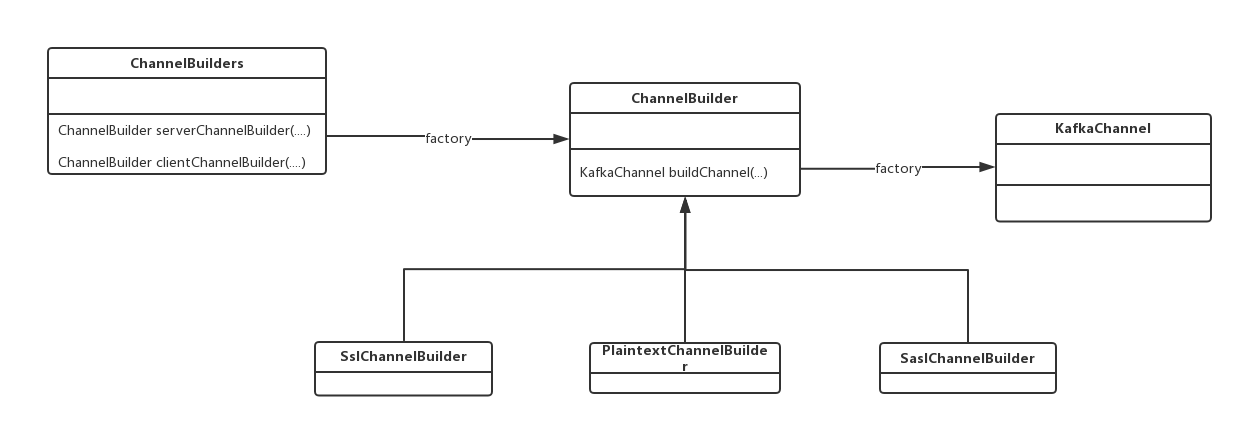KafkaChannel介绍
KafkaChannel负责基于socket的连接,认证,数据读取发送。它包含TransportLayer和Authenticator两个部分。TransportLayer负责数据交互,Authenticator负责安全验证。
框架图

ChannelBuilders
ChannelBuilders提供了实例化ChannelBuilder的工厂方法,clientChannelBuilder和serverChannelBuilder
public class ChannelBuilders {
// 这里构造为私有方法,表明这个类只提供类方法
private ChannelBuilders() { }
// 实例化客户端使用的ChannelBuilder
public static ChannelBuilder clientChannelBuilder(SecurityProtocol securityProtocol,
JaasContext.Type contextType, AbstractConfig config, ListenerName listenerName,
String clientSaslMechanism, boolean saslHandshakeRequestEnable) {
return create(securityProtocol, Mode.CLIENT, contextType, config, listenerName,
clientSaslMechanism, saslHandshakeRequestEnable, null);
}
// 实例化服务端使用的ChannelBuilder
public static ChannelBuilder serverChannelBuilder(ListenerName listenerName,
SecurityProtocol securityProtocol, AbstractConfig config,
CredentialCache credentialCache) {
return create(securityProtocol, Mode.SERVER, JaasContext.Type.SERVER, config, listenerName, null, true, credentialCache);
}
private static ChannelBuilder create(SecurityProtocol securityProtocol, Mode mode,
JaasContext.Type contextType, AbstractConfig config,
ListenerName listenerName, String clientSaslMechanism,
boolean saslHandshakeRequestEnable, CredentialCache credentialCache) {
.......
ChannelBuilder channelBuilder;
// 根据Protocol,选择不同的channelBuidler
switch (securityProtocol) {
case SSL:
// 基于ssl
requireNonNullMode(mode, securityProtocol);
channelBuilder = new SslChannelBuilder(mode);
break;
case SASL_SSL:
case SASL_PLAINTEXT:
// 基于sasl
requireNonNullMode(mode, securityProtocol);
JaasContext jaasContext = JaasContext.load(contextType, listenerName, configs);
channelBuilder = new SaslChannelBuilder(mode, jaasContext, securityProtocol,
clientSaslMechanism, saslHandshakeRequestEnable, credentialCache);
break;
case PLAINTEXT:
case TRACE:
// 没有任何加密
channelBuilder = new PlaintextChannelBuilder();
break;
default:
throw new IllegalArgumentException("Unexpected securityProtocol " + securityProtocol);
}
channelBuilder.configure(configs);
return channelBuilder;
}
PlaintextChannelBuilder类
ChannelBuidler是接口,实现其接口的有PlaintextChannelBuilder, SaslChannelBuilder,SslChannelBuilder。其中PlaintextChannelBuilder最为简单,所以这里以它为例。 ChannelBuidler中最主要的方法是buildChannel,它会创建transportLayer和authenticator,来实例化KafkaChannel。
public class PlaintextChannelBuilder implements ChannelBuilder {
public KafkaChannel buildChannel(String id, SelectionKey key, int maxReceiveSize) throws KafkaException {
try {
// 实例化TransportLayer
PlaintextTransportLayer transportLayer = new PlaintextTransportLayer(key);
// 实例化Authenticator
Authenticator authenticator = new DefaultAuthenticator();
authenticator.configure(transportLayer, this.principalBuilder, this.configs);
// 返回KafkaChannel
return new KafkaChannel(id, transportLayer, authenticator, maxReceiveSize);
} catch (Exception e) {
log.warn("Failed to create channel due to ", e);
throw new KafkaException(e);
}
}
}
Selector回顾
先回到Selector的pollSelectionKeys方法,它表明了KafkaChannel方法是何时被调用
private void pollSelectionKeys(Iterable<SelectionKey> selectionKeys,
boolean isImmediatelyConnected,
long currentTimeNanos) {
Iterator<SelectionKey> iterator = selectionKeys.iterator();
while (iterator.hasNext()) {
SelectionKey key = iterator.next();
KafkaChannel channel = channel(key);
if (isImmediatelyConnected || key.isConnectable()) {
// 调用channel的finishConnect方法,处理连接
if (channel.finishConnect()) {
......
} else
continue;
}
if (channel.isConnected() && !channel.ready())
// 然后调用channel的prepare方法,做准备工作(比如ssl连接的握手过程)
channel.prepare();
if (channel.ready() && key.isReadable() && !hasStagedReceive(channel)) {
// 当channel准备工作完成,调用channel的read方法,读取请求
NetworkReceive networkReceive;
while ((networkReceive = channel.read()) != null)
addToStagedReceives(channel, networkReceive);
}
}
.......
}
KafkaChannel
KafkaChannel负责连接,数据读取,发送
public class KafkaChannel {
// 首先完成连接
public boolean finishConnect() throws IOException {
boolean connected = transportLayer.finishConnect();
if (connected)
state = ready() ? ChannelState.READY : ChannelState.AUTHENTICATE;
return connected;
}
public boolean isConnected() {
return transportLayer.isConnected();
}
public void prepare() throws IOException {
//然后握手
if (!transportLayer.ready())
transportLayer.handshake();
// 认证
if (transportLayer.ready() && !authenticator.complete())
authenticator.authenticate();
if (ready())
// 如果都完成,更新状态
state = ChannelState.READY;
}
public boolean ready() {
// 当transportLayer和authenticator都完成,channel才认为状态准备好了
return transportLayer.ready() && authenticator.complete();
}
// channel的读取请求
public NetworkReceive read() throws IOException {
NetworkReceive result = null;
if (receive == null) {
receive = new NetworkReceive(maxReceiveSize, id);
}
// 读取请求
receive(receive);
if (receive.complete()) {
receive.payload().rewind();
result = receive;
receive = null;
}
return result;
}
private long receive(NetworkReceive receive) throws IOException {
// 调用NetworkReceive的readFrom方法
return receive.readFrom(transportLayer);
}
// 设置send,但是并不着急发送,等待transportLayer写事件就绪
public void setSend(Send send) {
if (this.send != null)
// 只能一次发送一个Send
throw new IllegalStateException("Attempt to begin a send operation with prior send operation still in progress.");
this.send = send;
// 监听写事件
this.transportLayer.addInterestOps(SelectionKey.OP_WRITE);
}
// 如果没有发送完,返回null。如果发送完,返回send。并且更新this.send为null
public Send write() throws IOException {
Send result = null;
// 调用send发送
if (send != null && send(send)) {
result = send;
send = null;
}
return result;
}
private boolean send(Send send) throws IOException {
// 调用Send的writreTo方法
send.writeTo(transportLayer);
if (send.completed())
transportLayer.removeInterestOps(SelectionKey.OP_WRITE);
return send.completed();
}
NetworkReceive
NetworkReceive表示一个请求。数据格式为
| size | data |
size 表示data的长度,为4个字节的int类型 data则为请求的数据,长度为size
public class NetworkReceive implements Receive {
// channel的id,表示这个请求是属于哪个channel
private final String source;
// 只有4个字节,读取请求的size
private final ByteBuffer size;
// 请求数据的最大长度
private final int maxSize;
// 请求数据
private ByteBuffer buffer;
public NetworkReceive(int maxSize, String source) {
this.source = source;
// 这里只分配4个字节
this.size = ByteBuffer.allocate(4);
this.buffer = null;
this.maxSize = maxSize;
}
public long readFrom(ScatteringByteChannel channel) throws IOException {
return readFromReadableChannel(channel);
}
public long readFromReadableChannel(ReadableByteChannel channel) throws IOException {
int read = 0;
// 检查是否已经完成读取size
if (size.hasRemaining()) {
// 读取数据的前4个字节,表示请求数据的大小
int bytesRead = channel.read(size);
if (bytesRead < 0)
throw new EOFException();
read += bytesRead;
if (!size.hasRemaining()) {
// 如果读取完成
size.rewind();
// 获取请求数据的大小receiveSize
int receiveSize = size.getInt();
// 检查数据大小的合理
if (receiveSize < 0)
throw new InvalidReceiveException("Invalid receive (size = " + receiveSize + ")");
if (maxSize != UNLIMITED && receiveSize > maxSize)
throw new InvalidReceiveException("Invalid receive (size = " + receiveSize + " larger than " + maxSize + ")");
// 根据receiveSize,分配buffer
this.buffer = ByteBuffer.allocate(receiveSize);
}
}
// buffer已经分配了,表明size读取完
if (buffer != null) {
int bytesRead = channel.read(buffer);
if (bytesRead < 0)
throw new EOFException();
read += bytesRead;
}
return read;
}
// 返回请求数据
public ByteBuffer payload() {
return this.buffer;
}
// 当size和buffer都读取玩,则返回true
public boolean complete() {
return !size.hasRemaining() && !buffer.hasRemaining();
}
NetworkSend
NetworkSend只是继承ByteBufferSend,增加了两个类方法
public class NetworkSend extends ByteBufferSend {
public NetworkSend(String destination, ByteBuffer buffer) {
//为buffer添加sizeBuffer,然后初始化父类ByteBufferSend
super(destination, sizeDelimit(buffer));
}
// 为buffer添加一个size的sizeBuffer,组成ByteBuffer数组
private static ByteBuffer[] sizeDelimit(ByteBuffer buffer) {
return new ByteBuffer[] {sizeBuffer(buffer.remaining()), buffer};
}
// 实例化4个字节的ByteBuffer,使用int初始化
private static ByteBuffer sizeBuffer(int size) {
ByteBuffer sizeBuffer = ByteBuffer.allocate(4);
sizeBuffer.putInt(size);
sizeBuffer.rewind();
return sizeBuffer;
}
}
public class ByteBufferSend implements Send {
// 发送地址
private final String destination;
// 响应数据的总大小
private final int size;
protected final ByteBuffer[] buffers;
// remaining表示buffer中未写完的数据长度
private int remaining;
// 表示是否channel中还有数据未发送
private boolean pending = false;
public ByteBufferSend(String destination, ByteBuffer... buffers) {
this.destination = destination;
this.buffers = buffers;
// 计算所有buffer的总大小
for (ByteBuffer buffer : buffers)
remaining += buffer.remaining();
this.size = remaining;
}
@Override
public boolean completed() {
// 数据首先会从buffer中写入到channel,然后channel再把数据写入到真实的socket中
return remaining <= 0 && !pending;
}
@Override
public long writeTo(GatheringByteChannel channel) throws IOException {
// 写入到channel中
long written = channel.write(buffers);
if (written < 0)
throw new EOFException("Wrote negative bytes to channel. This shouldn't happen.");
// 更新remaining
remaining -= written;
// 检查pending状态
pending = TransportLayers.hasPendingWrites(channel);
return written;
}
}
PlaintextTransportLayer
上面NetworkReceive和NetworkSend调用了TransportLayer的方法, channel.write和channel.read。 TransportLayer是接口,PlaintextTransportLayer是实现TransportLayer的类之一,因为它比较简单,所以这里以它为例。
public class PlaintextTransportLayer implements TransportLayer {
private final SelectionKey key;
private final SocketChannel socketChannel;
public PlaintextTransportLayer(SelectionKey key) throws IOException {
this.key = key;
this.socketChannel = (SocketChannel) key.channel();
}
//调用socketChannel的read方法
public long read(ByteBuffer[] dsts) throws IOException {
return socketChannel.read(dsts);
}
//调用socketChannel的write方法
public int write(ByteBuffer src) throws IOException {
return socketChannel.write(src);
}
}
概括
类之间的关系。ChannelBuilders实例化ChannelBuilder,ChannelBuilder实例化TransportLayer和Authenticator, 然后实例化ChannelBuidler。ChannelBuidler然后实例化KafkaChannel,KafkaChannel使用NetworkSend表示发送数据,NetworkReceive表示接收数据。





















 689
689











 被折叠的 条评论
为什么被折叠?
被折叠的 条评论
为什么被折叠?








